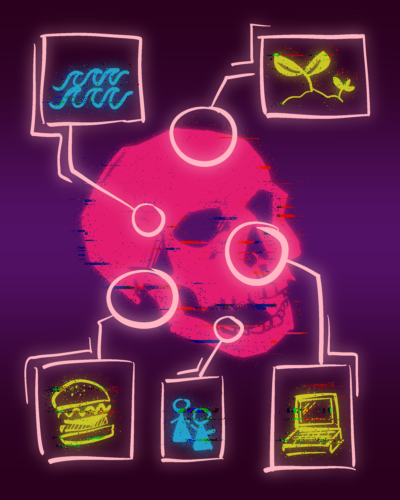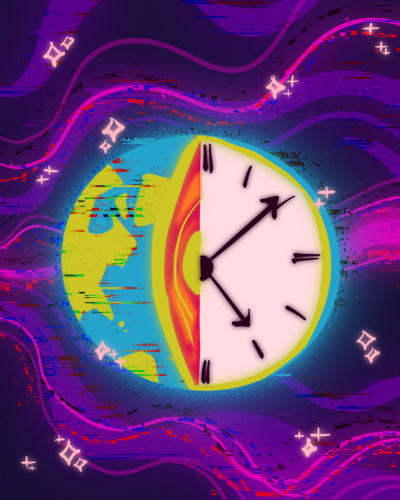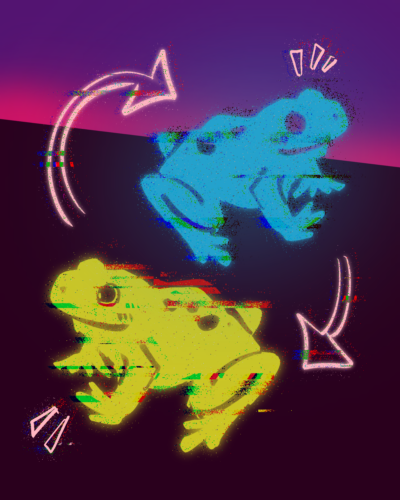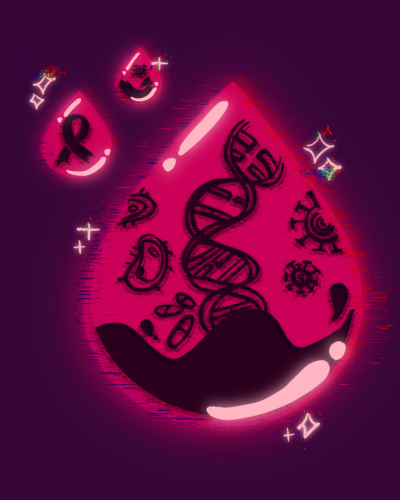Art Courtesy of Annli Zhu.
Introduction
The scientific method—observation, analysis, and conclusion—optimistically presumes a cycle of discovery without errors. But on the lab bench, in the chemical hood, and under the lens of the most well-resolved microscope, any successful research project is also fraught with failure. This timeline aims to chronicle a brief history of scientific failures—to acknowledge the mistakes and missteps built into the process of scientific discovery, and thereby to better appreciate what it takes to discover the science that makes it into the pages of a textbook and scrawled onto a classroom blackboard. The pursuit of scientific knowledge is continuous and unrelenting—a test of patience and tenacity. We hope to demystify the process of scientific discovery by shedding light on the struggles it entails both for the novice and the seasoned researcher alike.
4th Century BC: Spontaneous Generation
Aristotle formalized the theory of spontaneous generation, which stated that living organisms could be generated spontaneously out of nonliving matter. Common beliefs dictated that snails came from mud, scallops came from sand, and fleas came from dust. The theory wasn’t formally disproved until the 19th century.
Various Times: All That Glitters Is Not Gold
For centuries, alchemy attracted scores of scientists, including Isaac Newton, who hoped to transform base metals into gold and discover the elixir of life. Of course, these attempts were wholly unsuccessful. Still, they paved the way for chemistry as we know it today.

Early 1700s: The Theory That Burned Out
In the 18th century, the existence of a fire-like element called phlogiston was posited. Advancements in chemistry revealed that it was flawed, and by the end of the century, the theory was abandoned.

1828: The Life—and Death—of Vitalism
Vitalism was the theory that organic molecules could only be made by living systems that possessed a “vital force” integral to synthesis. In 1828, Frederick Woehler heated ammonium cyanate and produced urea, artificially synthesizing an organic molecule and discrediting the theory.

1840s: The Failure of Phrenology
Phrenology was the widespread belief that the shape of one’s skull could be examined to determine personality traits. The theory proposed that the brain was composed of a variety of muscles with different functions that were smaller or larger depending on how frequently they were used. This practice of measuring the skull’s lumps to assess a person’s mental traits was largely disproven by the 1840s and was eventually dismissed as pseudoscience.

1862: A Guesstimation Gone Wrong
Lord Kelvin used thermodynamic calculations to estimate the age of the Earth and the Sun. His numbers—that Earth was somewhere between twenty-four million and four hundred million years old—were a gross underestimation. Today, we know Earth’s true age is about 4.5 billion years.

1887: The Disappearing Act
In the 19th century, it was believed that the medium for light waves was an unseen substance that filled the universe: aether. In 1887, Michelson and Morley performed an experiment to detect aether wind. They compared the speed of light in perpendicular directions to detect the relative motion of matter through “aether wind.” Unsurprisingly, light traveled at the same speed in both directions, leading to the dismissal of this theory.

1912-1953: The Paleontological Prank
In 1911 and 1912, fossils discovered in Piltdown, England were believed to be those of the Piltdown Man, the missing link between apes and humans and the “earliest Englishman.” However, by 1953, it was discovered that the fossils were nothing but an elaborate forgery, involving a modern human skull and orangutan jawbone.

1918-1926: YSM’s “Troubled Years”
The Yale Scientific Monthly, founded in 1894, was the predecessor to the Yale Scientific Magazine. While it took off in its early years, it faced its biggest hurdle in its 19th volume. The editorial board of the Monthly began focusing on student affairs at Yale’s Sheffield Scientific School. This choice diluted scientific content, until 1926, when the magazine was revived in its original vision and resurrected as the Yale Scientific Magazine, which launched in 1927. The period from 1918 to 1926 has been dubbed by YSM’s Wikipedia page as “The Troubled Years.”

1928: The Serendipity of Penicillin
In 1928, Dr. Alexander Fleming noticed mold growing on his Petri dish on staphylococcus bacteria. Something seemed to prevent the surrounding bacteria from growing—which we now know to be penicillin. This accidental discovery paved the way for the rise of antibiotics and their therapeutic benefits.

1953: Pauling’s Triple Trouble
In 1953, Watson and Crick famously announced their discovery of DNA’s double helix. Just earlier that year, though, chemist Linus Pauling, a two-time Nobel Prize winner, proposed that DNA comprised three intertwined strands, which we know today to be false. In stark contrast with the success of his model for protein structure, his DNA model was incorrectly built inside-out, with three strands instead of two.

1962: Reversing Cellular Irreversibility
Until the late 19th century, it was widely believed that cell differentiation was irreversible: a cell, once specialized, could not return to its original stem cell state. In 1962, John Gurgeon, among others, proved this wrong by defining the cell reprogramming technique, cloning frogs using nuclear transfer from differentiated cells, thus reversing differentiation.

1998: A Vexing Claim About Vaccines
In 1998, Dr. Andrew Wakefield of the Royal Free Hospital School of Medicine published a study in The Lancet claiming that the measles, mumps, and rubella vaccine caused autism. The medical community quickly condemned the research study as clearly flawed in its design, and it was eventually retracted and declared fraudulent in 2011. However, Wakefield remains a popular figure among the growing anti-vax movement.

2017: Flat Earth Fanatics
In November 2017, the first annual Flat Earth International conference was held in Raleigh, North Carolina. Contrary to popular belief, the “scientific” theory that the Earth was flat rather than a sphere was most popular in the late 19th and early 20th century. Despite overwhelming (and obvious) evidence of Earth’s spherical nature, a small, yet vocal, contingent of people continue to promote the theory of a flat Earth.

2022: Theranos: From A Single Drop To A Huge Flop
In November 2022, Elizabeth Holmes, former CEO of infamous health tech company Theranos, was sentenced to over eleven years in prison for defrauding Theranos investors. Valued at ten billion dollars at the heights of its hype, Theranos claimed to have developed a blood test that could use just a single drop of blood to rapidly and accurately diagnose an array of health conditions. However, it was revealed shortly thereafter that Theranos had never in fact developed a functional blood test device, resulting in Holmes’ eventual arrest.

